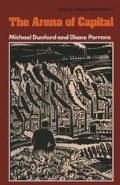Abstract
In the transition from manufacture to machinofacture, major disparities emerged between a small number of rapidly growing industrial areas and rural areas which were slowly deindustrialised and in the end were largely reduced to a sphere of agricultural activity. The most pronounced division was between the central-core area of England stretching from London to the North West and peripheral areas in Britain and Ireland.
Preview
Unable to display preview. Download preview PDF.
Notes and References
S. Pollard, Peaceful Conquest. The Industrialisation of Europe, 1760–1970 (New York: Oxford University Press, 1981) pp. 14–26.
M. Geddes, ‘Uneven Development and the Scottish Highlands’, University of Sussex Working Papers in Urban and Regional Studies, no. 17 (December 1979);
and H. C. Prince, ‘England circa 1850’, in H. C. Darby (ed.), A New Historical Geography of England after 1600 (Cambridge: Cambridge University Press, 1976) ch. 2, p. 159.
H. C. Darby, ‘The Age of the Improver: 1600–1800’, in Darby (ed.), A New Historical Geography, ch. 1, pp. 81–2.
E. J. Hobsbawm, Industry and Empire (Harmondsworth: Penguin, 1969) p. 34.
Marx, Capital. A Critique of Political Economy, vol. I (Harmondsworth: Penguin, 1976) p. 1021.
Ibid, pp. 1021 and 469–70.
S. Alexander, ‘Women’s Work in Nineteenth Century London: a Study of the Years 1820–50’, in J. Mitchell and A. Oakley (eds), The Rights and Wrongs of Women (Harmondsworth: Penguin, 1976) ch. 2, pp. 75–9.
Marx, Capiteti, vol. I, p. 461.
Ibid, pp. 492–508.
Ibid, p. 497.
Ibid, pp. 1025–7.
Ibid, p. 545.
I. Pinchbeck, Women Workers and the Industrial Revolution, 1750–1850 (London: Frank Cass, 1977) p. 117.
G. Stedman Jones, ‘Class Struggle and the Industrial Revolution’, New Left Review, no. 90 (March–April 1975) pp. 35–69, pp. 50–3 and 63–5; and
W. Lazonick, ‘Industrial Relations and Technical Change: the Case of the Self Acting Mule’, Cambridge Journal of Economics, vol. 3, no. 3 (September 1979)pp. 231–62, pp. 257–8.
D. Landes, The Unbound Prometheus. Technological Change and Industrial Development in Western Europe from 1750 to the Present (Cambridge: Cambridge University Press, 1969) pp. 187–8.
S. Pollard, Peaceful Conquest, p. 26.
Pinchbeck, Women Workers, p. 116; and P. Deane, The First Industrial Revolution (Cambridge: Cambridge University Press, 1969) pp. 85–7.
S. D. Chapman, cited in Pollard, Peaceful Conquest, p. 26.
Ibid, p. 25.
E. P. Thompson, The Making of the English Working Class (Harmondsworth: Penguin, 1974) pp. 307–9, 334 and 337–40.
Ibid, pp. 333–4.
Hobsbawm, Industry and Empire, p. 65.
Lazonick, ‘The Case of the Self Acting Mule’, p. 258.
Hobsbawm, Industry and Empire, p. 58.
Marx, Capital, vol. I, pp. 517 and 527.
Ibid, p. 532.
Ibid, pp. 528–9.
Ibid, pp. 531–2.
Ibid, pp. 530–1.
Stedman Jones, ‘Class Struggle and the Industrial Revolution’, p. 53.
J. Liddington and J. Norris, ‘No Cause Can Be Won Between Dinner and Tea, and Most of Us Who Were Married Had to Work With One Hand Tied Behind Us’: The Rise of the Women’s Suffrage Movement (London: Virago, 1978) p. 54.
Ibid, pp. 47–54, 60 and 93.
Hobsbawm, Industry and Empire, p. 73.
Ibid, pp. 73–8 and 122–6; and Stedman Jones, ‘Class Struggle’, pp. 53–4.
Stedman Jones, ‘Class Struggle’, pp. 65–8.
See, for example, F. Engels, The Condition of the Working Class in England (London: Panther, 1969);
and A. Briggs, Victorian Cities (Harmondsworth: Penguin, 1975).
A. E. Musson, The Growth of British Industry (London: Batsford, 1978) pp. 79–80.
J. Anderson, ‘Engels’ Manchester: Industrialisation, Workers’ Housing and Urban Ideologies’, Architecture Association Studies in the Political Economy of Cities and Regions, no. 1 (1977) pp. 11–12.
Cited in Hobsbawn, Industry and Empire, p. 56.
Musson, The Growth of British Industry, pp. 82–3.
Hobsbawm, Industry and Empire, p. 5 8.
Liddington and Norris, One Hand Tied Behind Us, p. 57.
Anderson, ‘Engels’ Manchester’, p. 19.
W. Farr, cited in A. Harris, ‘Changes in the Early Railway Age: 1800–1850’, in H. C. Darby (ed.), A New Historical Geography, ch. 3, p. 168.
Deane, The First Industrial Revolution, p. 148.
Anderson, ‘Engels’ Manchester’, pp. 3–23.
A. Scott, The Urban Land Nexus and the State (London: Pion, 1980)p.196.
Ibid, pp. 194–203.
J. Foster, Class Struggle and the Industrial Revolution. Early Industrial Capitalism in Three English Towns (London: Weidenfeld & Nicolson, 1974) pp. 19–22.
Copyright information
© 1983 M. F. Dunford and D. C. Perrons
About this chapter
Cite this chapter
Dunford, M., Perrons, D. (1983). The Transition from Manufacture to Machinofacture 1780–1850. In: The Arena of Capital. Critical Human Geography. Palgrave, London. https://doi.org/10.1007/978-1-349-17107-1_13
Download citation
DOI: https://doi.org/10.1007/978-1-349-17107-1_13
Publisher Name: Palgrave, London
Print ISBN: 978-0-333-28263-2
Online ISBN: 978-1-349-17107-1
eBook Packages: Palgrave Social & Cultural Studies CollectionSocial Sciences (R0)

